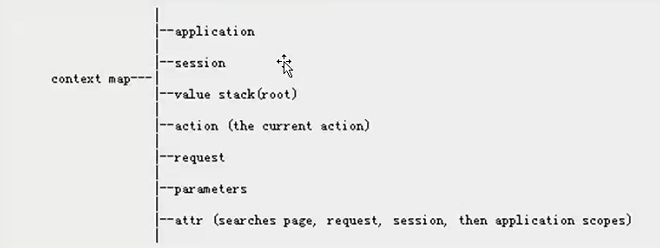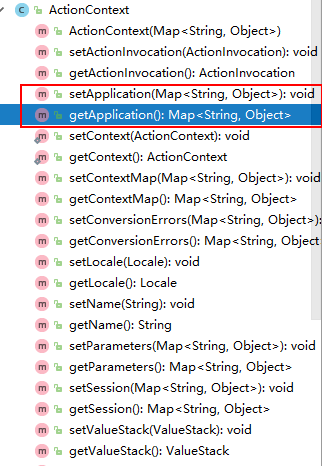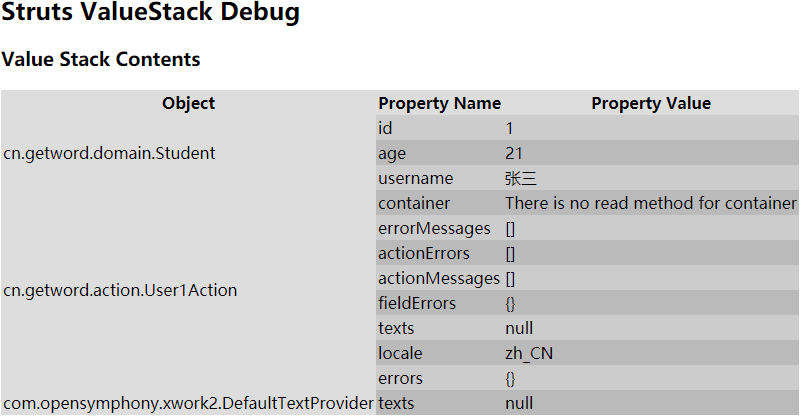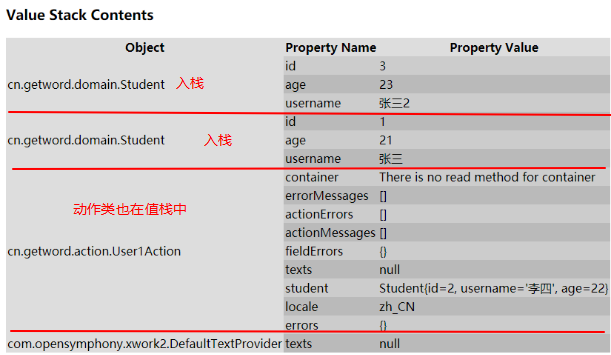OGNL,表达式上下文ContextMap
1.OGNL表达式
object graph navigation language:对象图导航语言
存取对象属性;调用对象方法;字段类型转换等。
<input type="text" name="user.username" />
2.OGNL表达式的使用场景
2.1 在jsp中
s1.导入struts标签库:
<%@ taglib prefix="s" uri="/struts-tags" %>
s2. 只能在在struts标签库中使用OGNL表达式,不能再其他地方用
对于property的value默认使用OGNL表达式。
对于radio的list属性默认使用OGNL表达式
纯字符串:
<s:property value="%{'OGNLExpression'}" />
<s:property value="'OGNLExpression'" />
使用OGNL表达式:
<s:textfield value="%{name}" label="姓名" />
调用对象方法:
<s:textfield value="%{'admin'.length()}" label="姓名" />
<s:textfield value="%{'admin'.split('m')}" label="姓名" />
调用静态类的静态成员:
<s:property value="@java.lang.Math@PI" /><br /> 静态成员
<constant name="struts.ognl.allowStaticMethodAccess" value="true" /> 开启允许调用OGNL静态方法【struts.xml中配置】
<s:property value="@java.lang.Math@random()" /> 静态方法
操作List对象:{'',''} -->ArrayList-->['','']
<s:radio name="gender" list="{'male','female'}" label="性别"></s:radio> list属性默认使用OGNL表达式

操作Map对象:#{'':'' , '':''} -->Map -->{'':'', '':''}
<s:radio name="sex" list="#{'1':'男','2':'女'}" label="性别2"></s:radio>

3.OGNL表达式上下文:ContextMap
contextMap是struts2封装好的一次请求可能出现的最大的数据容器。
结构:是一个Map结构 {String:Object}
里面存的数据:

- application:ServletContext应用对象
- session:HttpSession
- valueStack:值栈 List类型
- action:当前执行的动作类相关数据 【不是Map类型】
- request:HttpServletRequest
- parameters:请求参数
- attr:四大域的属性数据
除了ValueStack和action不是Map类型的,其他的都是Map类型{String : Object}
4.ActionContext和ContextMap的关系
ActionContext可以获取四大域对象,他是个工具类。
//
// Source code recreated from a .class file by IntelliJ IDEA
// (powered by Fernflower decompiler)
// package com.opensymphony.xwork2; import com.opensymphony.xwork2.inject.Container;
import com.opensymphony.xwork2.util.ValueStack;
import java.io.Serializable;
import java.util.HashMap;
import java.util.Locale;
import java.util.Map; public class ActionContext implements Serializable {
static ThreadLocal<ActionContext> actionContext = new ThreadLocal();
public static final String ACTION_NAME = "com.opensymphony.xwork2.ActionContext.name";
public static final String VALUE_STACK = "com.opensymphony.xwork2.util.ValueStack.ValueStack";
public static final String SESSION = "com.opensymphony.xwork2.ActionContext.session";
public static final String APPLICATION = "com.opensymphony.xwork2.ActionContext.application";
public static final String PARAMETERS = "com.opensymphony.xwork2.ActionContext.parameters";
public static final String LOCALE = "com.opensymphony.xwork2.ActionContext.locale";
public static final String TYPE_CONVERTER = "com.opensymphony.xwork2.ActionContext.typeConverter";
public static final String ACTION_INVOCATION = "com.opensymphony.xwork2.ActionContext.actionInvocation";
public static final String CONVERSION_ERRORS = "com.opensymphony.xwork2.ActionContext.conversionErrors";
public static final String CONTAINER = "com.opensymphony.xwork2.ActionContext.container";
private Map<String, Object> context; public ActionContext(Map<String, Object> context) {
this.context = context;
} public void setActionInvocation(ActionInvocation actionInvocation) {
this.put("com.opensymphony.xwork2.ActionContext.actionInvocation", actionInvocation);
} public ActionInvocation getActionInvocation() {
return (ActionInvocation)this.get("com.opensymphony.xwork2.ActionContext.actionInvocation");
} public void setApplication(Map<String, Object> application) {
this.put("com.opensymphony.xwork2.ActionContext.application", application);
} public Map<String, Object> getApplication() {
return (Map)this.get("com.opensymphony.xwork2.ActionContext.application");
} public static void setContext(ActionContext context) {
actionContext.set(context);
} public static ActionContext getContext() {
return (ActionContext)actionContext.get();
} public void setContextMap(Map<String, Object> contextMap) {
getContext().context = contextMap;
} public Map<String, Object> getContextMap() {
return this.context;
} public void setConversionErrors(Map<String, Object> conversionErrors) {
this.put("com.opensymphony.xwork2.ActionContext.conversionErrors", conversionErrors);
} public Map<String, Object> getConversionErrors() {
Map<String, Object> errors = (Map)this.get("com.opensymphony.xwork2.ActionContext.conversionErrors");
if (errors == null) {
errors = new HashMap();
this.setConversionErrors((Map)errors);
} return (Map)errors;
} public void setLocale(Locale locale) {
this.put("com.opensymphony.xwork2.ActionContext.locale", locale);
} public Locale getLocale() {
Locale locale = (Locale)this.get("com.opensymphony.xwork2.ActionContext.locale");
if (locale == null) {
locale = Locale.getDefault();
this.setLocale(locale);
} return locale;
} public void setName(String name) {
this.put("com.opensymphony.xwork2.ActionContext.name", name);
} public String getName() {
return (String)this.get("com.opensymphony.xwork2.ActionContext.name");
} public void setParameters(Map<String, Object> parameters) {
this.put("com.opensymphony.xwork2.ActionContext.parameters", parameters);
} public Map<String, Object> getParameters() {
return (Map)this.get("com.opensymphony.xwork2.ActionContext.parameters");
} public void setSession(Map<String, Object> session) {
this.put("com.opensymphony.xwork2.ActionContext.session", session);
} public Map<String, Object> getSession() {
return (Map)this.get("com.opensymphony.xwork2.ActionContext.session");
} public void setValueStack(ValueStack stack) {
this.put("com.opensymphony.xwork2.util.ValueStack.ValueStack", stack);
} public ValueStack getValueStack() {
return (ValueStack)this.get("com.opensymphony.xwork2.util.ValueStack.ValueStack");
} public void setContainer(Container cont) {
this.put("com.opensymphony.xwork2.ActionContext.container", cont);
} public Container getContainer() {
return (Container)this.get("com.opensymphony.xwork2.ActionContext.container");
} public <T> T getInstance(Class<T> type) {
Container cont = this.getContainer();
if (cont != null) {
return cont.getInstance(type);
} else {
throw new XWorkException("Cannot find an initialized container for this request.");
}
} public Object get(String key) {
return this.context.get(key);
} public void put(String key, Object value) {
this.context.put(key, value);
}
}
ActionContext
ContextMap是一个Map类型的对象,key为application等,value为Map类型的数据,但是通过ContextMap.get(application)返回的是Object类型的对象。因此可以通过ActionContext工具类直接获取Map对象。

域对象:
com.opensymphony.xwork2.dispatcher.HttpServletxxx
ContextMap中的数据:
com.opensymphony.xwork2.ActionContext.application
源码分析:ActionContext.java
static ThreadLocal<ActionContext> actionContext = new ThreadLocal();
private Map<String, Object> context; //传说中的ContextMap
public static ActionContext getContext() {
return (ActionContext)actionContext.get();
}
获取线程安全的ActionContext对象
ServletActionContext.java
public static HttpServletRequest getRequest() {
return (HttpServletRequest)ActionContext.getContext().get("com.opensymphony.xwork2.dispatcher.HttpServletRequest");
}
通过ActionContext.getContext()静态方法可以获取一个线程安全的ActionContext对象,然后再调用里面的get方法:

由此可知:域对象(ServletContext)、域对象数据(Map)都是存在context(Map<String, Object>)属性中的
注意:ActionContext的声明周期为一次请求。
ContextMap: {key: value}
application:Map
ActionContext.application:Map
servlet.ServletContext:ServletContext
往ContextMap中存入数据:
public class UserAction extends ActionSupport {
public String index(){
ActionContext actionContext = ActionContext.getContext();
actionContext.put("contextMapKey","this is ContextMap value"); //底层:ActionContext.context.put()
return SUCCESS;
}
}
往ServletContext域中存入数据:application,
取值:#ContextMap的key.key
<s:property value="#application.application1" />
5.ValueStack
值栈中的数据不需要使用#访问。而ContextMap中的Value需要使用#Key
valueStack是一个List集合
//
// Source code recreated from a .class file by IntelliJ IDEA
// (powered by Fernflower decompiler)
// package com.opensymphony.xwork2.util; import java.util.Map; public interface ValueStack {
String VALUE_STACK = "com.opensymphony.xwork2.util.ValueStack.ValueStack";
String REPORT_ERRORS_ON_NO_PROP = "com.opensymphony.xwork2.util.ValueStack.ReportErrorsOnNoProp"; Map<String, Object> getContext(); void setDefaultType(Class var1); void setExprOverrides(Map<Object, Object> var1); Map<Object, Object> getExprOverrides(); CompoundRoot getRoot(); void setValue(String var1, Object var2); void setParameter(String var1, Object var2); void setValue(String var1, Object var2, boolean var3); String findString(String var1); String findString(String var1, boolean var2); Object findValue(String var1); Object findValue(String var1, boolean var2); Object findValue(String var1, Class var2); Object findValue(String var1, Class var2, boolean var3); Object peek(); Object pop(); void push(Object var1); void set(String var1, Object var2); int size();
}
ValueStack.java
方法:

OGNLValueStack:继承ValueStack
CompoundRoot root;
public Object peek() {
return this.root.peek();
} public Object pop() {
return this.root.pop();
} public void push(Object o) {
this.root.push(o);
}
使用valueStack存入数据:User1Action.java
public class User1Action extends ActionSupport {
public String login(){
ActionContext actionContext = ActionContext.getContext();
//valueStack
ValueStack valueStack = actionContext.getValueStack();
Student student = new Student();
student.setId(1);
student.setUsername("张三");
student.setAge(21);
valueStack.push(student);
return SUCCESS;
}
}

不建议把Map和List加到值栈中,建议存入到ContextMap。对于POJO建议存入到值栈中
取值:先从栈顶找,有没有username的对象,再看有没有username的属性
<s:property value="username" />
栈顶:
<s:property value="[0].username" />
<s:property value="[1].username" />
OGNL通过ValueStack.findValue方法找值
6.struts2中使用EL
(1)struts2中的EL :由于request对象被增强了,valueStack和ContextMap本质上是存入到request对象中,因此ActionContext是每次请求实例化一次。
page --> request --> valueStack --> ContextMap --> session --> application

案例:
public class User2Action extends ActionSupport {
public String index(){
ActionContext actionContext = ActionContext.getContext();
//valueStack
Student student1 = new Student();
student1.setId(1);
student1.setUsername("张三");
student1.setAge(21);
Student student2 = new Student();
student2.setId(3);
student2.setUsername("张三2");
student2.setAge(23);
Map<String, Object> contextMap = actionContext.getContextMap();
List<Student> list = new ArrayList<Student>();
list.add(student1);
list.add(student2);
contextMap.put("students", list);
return SUCCESS;
}
}
User2Action
EL :查找顺序 page>request>valueStack>ContextMap>session >application
<table border="1">
<tr>
<th>姓名</th>
<th>年龄</th>
</tr>
<c:forEach items="${students}" var="s">
<tr>
<td>${s.username}</td>
<td>${s.age}</td>
</tr>
</c:forEach> </table>
end
最新文章
- jquery 的一些基本操作
- T-SQL 高级查询
- python核心编程第六章练习6-12
- Plug-in 'org.eclipse.cdt.ui' contributed an invalid Menu Extension
- Effective Modern C++翻译(4)-条款3:了解decltype
- IOC使用Unity 实现依赖注入
- js数组反转
- (转)基于即时通信和LBS技术的位置感知服务(二):XMPP协议总结以及开源解决方案
- Ubuntu 12.04下搭建Qt开发环境
- Mysql学习基础语法
- 根据identifier从StoryBoard中获取对象,UIButton的图片文件位置
- The POM for * is invalid
- ACE入门——ACE构建
- Go-技篇第二 命名规范
- Magento 架构原则
- PTA-栈
- 利用python破解sqlserver账号密码
- 一文带你看懂cookie,面试前端不用愁
- DHT11温度传感器应用电路
- UE4的AI学习(1)——基本概念